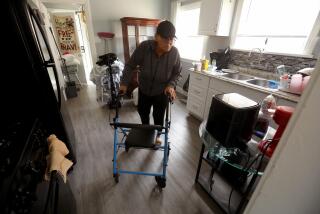Wrecking Ball Brings Hope to Slum : Northern Ireland: Gunmen and criminals have given way to trees and driveways in Belfast’s infamous Divis Flats.
- Share via
BELFAST, Northern Ireland — For the Roman Catholic residents of Divis Flats, the wrecking ball was the best thing that ever broke into their homes.
Over the years, British soldiers kept watch on the huge apartment complex and hammered in more than a few doors looking for IRA weapons.
Gunmen and criminals were everyone’s neighbors. Glue-sniffing kids spent long, raucous evenings huddled around the burned-out shells of stolen cars. The garbage chutes were blocked, the elevators perpetually “banjaxed.”
Banjaxed, an Irish way of saying beaten up and broken down, pretty much characterized life in Northern Ireland’s most notorious slum.
“My new house is heaven. The flats were hell,” said Frank Gillen, former chairman of the Divis Demolition Committee, a now-defunct pressure group whose only purpose had been to get rid of the old apartments.
Three-fourths of Divis has been replaced by tidy red-brick houses with gardens and driveways. The three remaining blocks of flats were evacuated in August to make way for more new homes.
Like most residents, Gillen believes local pressure tactics forced the government to level the place. In the early 1980s, his Demolition Committee sought to make the complex uninhabitable, wrecking apartments as they became vacant.
“We took out baths, toilets, sinks, electric fittings,” he said. “We ripped off good doors, the good windies. Then we’d wreck the interior with sledgehammers, so’s nobody could inhabit it. Good clean fun.”
Divis illustrates what many see as the main success in 21 years of direct British rule of Northern Ireland. Reacting to discrimination against Catholics in housing, the government has transformed whole ghettos, particularly in poor Catholic areas of Belfast where support for the Irish Republican Army is high.
“The new house? It’s a million-percent improvement,” acknowledged Fra McCann, a councilor for Sinn Fein, the political party that supports the IRA’s violent campaign against British rule.
McCann served several years in prison for IRA-related activities and now devotes his time to unpaid political work. The British welfare system covers the rent for his new house, but he offers no thanks.
“I wouldn’t give the British government an ounce of credit,” he said. “It’s local people and their determination that got the flats tore down.”
Divis, built in 1966-72, replaced a warren of 19th-Century row houses. Its many detractors note with irony how church and political leaders had wanted the traditional community kept together under one densely populated “roof.”
“The IRA have made a lot of propaganda out of Divis as an issue, that it was an example of British indifference to ordinary people,” said the Rev. Matt Wallace, a priest at St. Peter’s Cathedral in the heart of Divis. “But the fact is that the flats were an improvement on the Pound Loney slums, which had no bathrooms or heat to speak of.
“It’s easy to see now that Divis was a terrible idea.”
Wallace likened the layout to a maze. The chain of connecting balconies and stairwells sheltered criminal gangs and the IRA, which threw up barricades that kept out army and police patrols until 1973. Some of the worst rioting during the 1981 prison hunger strikes was in Divis.
In a series of public meetings, planners from the government Housing Executive found that the Divis residents wanted a traditional ground-level neighborhood.
“Basically, they want the same streets and houses their grannies had,” said Jackie Boyle, chief architect of the $15-million redevelopment that began in 1984.
West Belfast’s considerable hoodlum class is already waxing nostalgic about Divis.
“I’ll miss the flats. Sure we all will,” said 15-year-old Paul Harkett, who stood with his “corner boy” friends, kicking at overgrown grass and sharing cigarettes.
Some were trying to scrape up enough cash for a bag of “blow” (marijuana) and a few “E-tabs” (Ecstasy tablets).
“The weekends here is mad,” Harkett said approvingly. “You’ve fightin’, (stolen) cars come in for to joy ride in. The peelers (police) don’t come into the flats at night. They’re scared a-gettin’ bombed or shot by the Rah (IRA) or run down by joy riders.”
One building of the former project will remain: Divis Tower, a 19-story apartment that houses 100 pensioners and, on the roof, a well-armored British army outpost.
It commands a view of the nearby “peace line,” the walls and fences that separate the Divis district and other Catholic areas from the Protestants of the Shankill Road.
More to Read
Sign up for Essential California
The most important California stories and recommendations in your inbox every morning.
You may occasionally receive promotional content from the Los Angeles Times.










